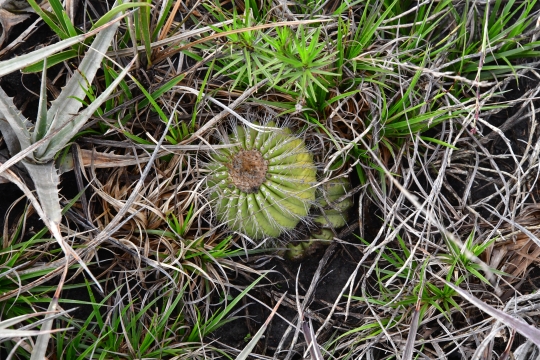Yesterday’s fall at the first stop of the trip had left me questioning if I was becoming too old for these sort of trips. But these thoughts blended with trying to work out why I was feeling unusually tired. Marlon had suggested that November was not the best time of year to travel in Minas Gerais – it was the hottest time of year and the start of the rainy season, creating high humidity. Marlon suggested that I was dehydrated and needed to drink more bottled water. That was easy, with plenty of bottles bought at the local supermarket before setting out. I had insisted on the dates because in 2009 we had travelled here at exactly the same time without any problems. But then, the weather can be notoriously unpredictable.
Today I took images at:
- S3658 – Uebelmannia pectinifera subsp. flavispina
 S3658: Uebelmannia pectinifera subsp. flavispina
S3658: Uebelmannia pectinifera subsp. flavispina
and Cipocereus minensis, Dyckia sp. Orchidaceae sp. Tillandsia sp and Velloziaceae sp.
- S3659 – Uebelmannia pectinifera subsp. flavispina, Bromeliad sp. C. minensis, Eriocaulaceae sp (Everlasting flower), Lichen, Orchidaceaa sp and Velloziaceae.

There is often a distinct difference between the juvenile and adult spination of Uebelmannia to the point that they look like ‘different’ species. When grafted, the juvenile spination persists longer than in nature. This is the case for the plant described as Uebelmannia pectinifera var. eriocactoides but its discoverer has admitted to me that in habitat, larger plants look like ‘normal’ adult U. pectinifera. Plants offered for sale are always grafted.
- S3660 – Datas
Images taken are of the typical colonial architecture. No plants photographed. - S3661 – Uebelmannia pectinifera subsp. flavispina

This population contained tagged plants as part of a population study. Metal tags were tied to the plants by a metal wire. All tagged plants had died. A few plants were missed by the taggers and were healthy. I suspect that heavy rains can turn the puddles into electrical batteries rather like experiments I remember from school. I hope that the students recorded and reported their results, so that others can learn from this and avoid a repeat. I have seen other population studies (e.g. Pediocactus bradei near Navajo Bridge, AZ), where the tag is secured into the soil by a nail, but neither metal objects touch the plants. On a recent visit to that location some of the discs were made of black plastic. There was no evidence of plants being affected by the tagging. - S3661 – night out in Diamantina, no plants photographed

Alain Buffel and John Child used as scale for the 3.5 litre beer glass. I should say that the six of us shared two such glasses! There was no space on the table for one each!!

Leave a comment